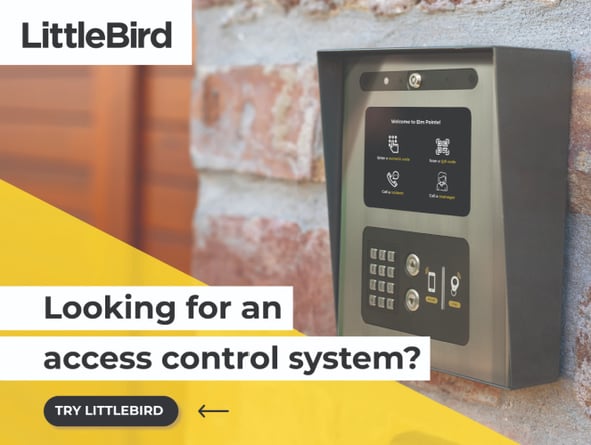Identifying Areas for Access Control in a Multifamily Community
What do a residential property, a bank, and a local grocery store all have in common? They all require an efficient and manageable physical access control system.
From keeping the laundry room exclusive to residents to securing areas for only specific staff members, physical access control plays an important role in keeping your multifamily housing property, residents, and data safe.
This article covers:
- What is physical access control (PAC)?
- Why is physical access control important?
- 10 common areas multifamily communities need access control
What is physical access control?
Physical access control (PAC) is the act of managing who has access to physical entry points on your multifamily residence The most basic form of physical access control is locked doors; however, buildings that require high-level security have much more extreme protocols put in place.
PAC’s goal is to only provide residents and property staff access to areas they need and nothing more.
🔐 Searching for the best access control system for apartments? Discover the best options in 2023.
Why is physical access control important for a multifamily community?
Physical access control’s main purpose is to increase the security of your property and data stored on-site. Other benefits of access control include reduced theft and damage, audits of all entry-point traffic, increased property staff productivity, and a convenient and secure experience for residents and their guests.
.jpg?width=1200&height=634&name=Blank%201200%20x%20634%20(1).jpg)
10 common areas multifamily communities need access control
The first step to creating a robust physical access control system for a multifamily property is identifying which areas must be secured. While entry points are obvious, like your property’s front gate and door, some aren’t as clear.
From the main entrance to elevators, we’ll cover 8 of the most common areas multifamily properties need access control.
Let’s get into it!
1. Main entrance
Securing your property’s main entrances is usually top of mind for most residential communities. Unlike hotel buildings where there is typically a receptionist to aid in the check-in process, oftentimes a multifamily reception area is automated and requires residents and their guests to present credentials.

2. Parking garage
No one likes not finding a parking spot – especially at their place of residence. To avoid squatters or unauthorized individuals clogging up your parking area, gates or another barrier may be placed at the front of the garage.
3. Maintenance closets
Keep grabby hands away from the property’s vacuums, cleaning chemicals, and other maintenance tools by keeping them locked away. Some access control systems allow you to define which roles (i.e. “Maintenance staff” or “Property staff”) have permission to access this controlled area.
4. Server rooms
Due to the nature that servers hold confidentially sensitive information, they are required to be stored in a physically controlled room. Only a few people should have access including an IT staff member and one essential property staff member. This helps minimize the risk of theft or malicious damage.
5. Areas with a security risk
Much like server rooms, these are areas where confidential information might be stored. For example, you may consider securing staff offices, storage rooms, or meeting rooms.
6. Resident amenity spaces
Amenities spaces like fitness centers, pools, laundry rooms, rooftop access, or meeting rooms boost multifamily property’s value by 1) offering convenience and 2) giving residents a safe and exclusive space from the general public. In order to keep this value intact, physical access control is essential.
7. Elevators
Elevator access controls often are used to manage how many occupy the elevator at one time as well as restrict access to certain floors.
8. Common areas
Common areas include emergency exits, windows, or unsecured exterior doors are common ways intruders sneak into a property undetected. Physical access control can lock these doors only from the outside, so residents inside can still exit safely in the event of an emergency.
9. Mailrooms
Mailrooms are another area in multifamily communities that require access control. These areas contain residents' mail and packages, and without proper access control, unauthorized individuals could enter the mailroom and potentially steal or damage these items. Access control systems can help to prevent this by requiring residents to use a key fob or other forms of identification to enter the mailroom.
10. Garbage/Recycling rooms
Garbage and recycling rooms are meant to be used exclusively by residents and their guests, and without proper access control, unauthorized individuals could enter these areas and potentially cause safety concerns or create unsanitary conditions.
In summary…
- Physical access control (PAC) is the act of managing a resident or property staff’s access to entry points and areas they need and nothing more.
- The benefits of physical access control include a safer environment for all multifamily occupants and staff, greater convenience for residents and their guests, and higher property value.
- Common areas multifamily properties should remember in their access control plan are main entrances, parking garages, maintenance closets, server rooms, areas with security risk, resident amenity spaces, elevators, common areas, mailrooms, and garbage rooms.
-1.png?width=5935&height=1114&name=NEW%20LU%20%E2%80%93%20Long%20Logo%20%E2%80%93%20Dark%20(1)-1.png)

Comments